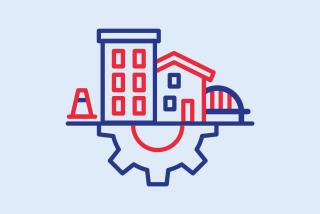House Panel Votes for Tougher Standard on S&L; Cash Reserves
- Share via
WASHINGTON — The House Banking Committee on Thursday approved tough new financial standards for the nation’s beleaguered savings and loan industry, requiring S&L; owners to provide billions of dollars in additional capital as the foundation of a rescue plan for the federal deposit insurance system.
The bipartisan vote of 36 to 15 was a victory for the Bush Administration and committee Chairman Henry B. Gonzalez (D-Tex.), who sought a tougher requirement than the Senate had approved last week.
Treasury Secretary Nicholas F. Brady praised the House action. “Requiring S&Ls; to put their own capital at risk ahead of the taxpayers’ money is the only way to prevent in the future the unsound business practices that contributed to the current crisis,” he said.
If the committee vote becomes part of the final legislation, the managements of 70 California S&Ls; with more than $200 billion in assets would be forced to raise additional funds to buttress the financial foundation of their institutions.
The Senate voted last week for S&L; owners to maintain $1.50 in capital for every $100 in loans made by the institution. The House measure would make the standard $3 for every $100.
Although a 3% capital requirement is the existing standard, the proposals would tighten the definition of what constitutes capital. The current definition includes intangibles that the new standard would not.
Under the House bill, S&Ls; would have six years to reach the new target. The standard would be set at $1.50 next year and rise gradually to $3 by 1995. In the Senate bill, the $1.50 standard would take effect in 1991.
In addition, the House measure would allow federal regulators to give S&Ls; temporary waivers if they were to fall short of the standards in a particular year but were making steady progress towards the 3% goal.
“It gives them the time they need to raise capital,” said Rep. Richard H. Lehman (D-Sanger). “This is a very substantial improvement” over the Senate plan, he said.
The capital standards issue is one of the most important features of the complex S&L; rescue effort, which will cost the industry and taxpayers an estimated $157 billion over the next 10 years. That sum will be necessary to close several hundred insolvent institutions and to pay depositors, whose accounts up to $100,000 are insured by the federal government.
Assurances Sought
Legislators sought assurances that S&L; owners would put more of their own funds into the business to avoid a repetition of recklessness of the early 1980s, when some S&Ls; moved away from home mortgages into such exotic ventures as restaurants and horse breeding.
The House committee vote came despite complaints from the S&L; industry that hundreds of institutions might go out of business or merge with other S&Ls; or banks because they could not raise the additional funds.
“The solvent institutions earned only $3.4 billion last year,” said Jim Grohl, vice president of the U.S League of Savings Institutions. “Since 1980 and during some pretty good times, the industry has been able to raise only $20 billion in new capital. A lot of them just aren’t going to make it.”
The Bush Administration says that there are 453 S&Ls; with capital below the 3% standard and that they would need to raise $7.5 billion to meet it. But industry experts argue that many more S&Ls; would fall short of the 3% standard and would need to raise more than $13 billion.
The House bill, which would set a strict definition of capital, refers to “tangible capital,” which includes cash, securities, notes and other items that can be easily sold for cash. But “good will”--the value of an institution’s reputation--could not be counted toward the $3 per $100.
Gonzalez compared good will to “a soft ice cream cone in the July sun. Good will provides nothing if the institution goes down.”
Thursday’s action, if it becomes law, would send some major California S&Ls; into the marketplace seeking new capital. Some of the biggest include: First Nationwide of San Francisco, Imperial Savings of San Diego, Glendale Federal, American Savings of Stockton, Coast Savings of Los Angeles and California Federal of Los Angeles.
The Banking Committee will resume work on the S&L; bill on Monday.
THE FATE OF CALIFORNIA’S S&Ls;
Of 12 of California’s largest savings and loan institutions, half already meet the new capital requirement that the House version of the S&L; bailout bill would impose. The other half fall short of the requirement--that retained earnings and other forms of capital exceed 3% of assets--and would have to increase their capital reserves.
Assets Capital as S&L; City (in billions) share of assets Above 3% Columbia Beverly Hills $11.7 5.753% Home Federal San Diego 16.3 4.900 Great Western Beverly Hills 30.8 4.505 Great American First San Diego 13.0 4.107 World Savings Oakland 16.5 4.074 Home Savings Los Angeles 34.8 3.745 Below 3% California Federal Los Angeles $26.2 2.166% Coast Los Angeles 12.9 1.884 American Stockton 15.4 1.790 Glendale Federal Glendale 24.3 1.762 Imperial San Diego 12.3 1.329 First Nationwide San Francisco 26.2 1.159
Source: Federal Savings and Loan Insurance Corp. Data as of Dec. 31
More to Read
Inside the business of entertainment
The Wide Shot brings you news, analysis and insights on everything from streaming wars to production — and what it all means for the future.
You may occasionally receive promotional content from the Los Angeles Times.










